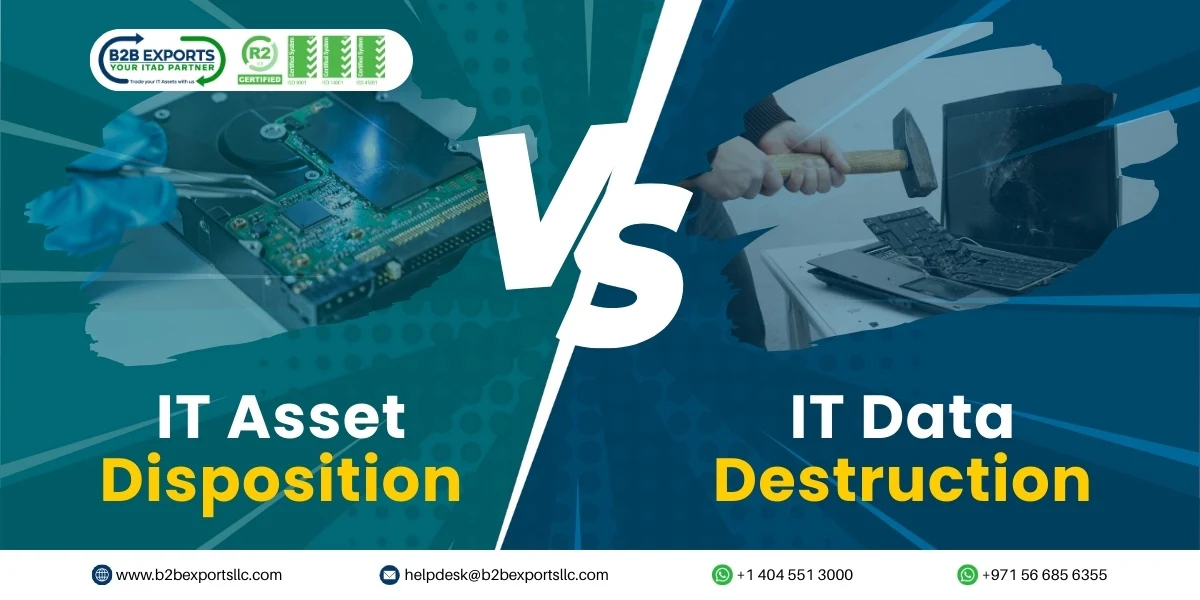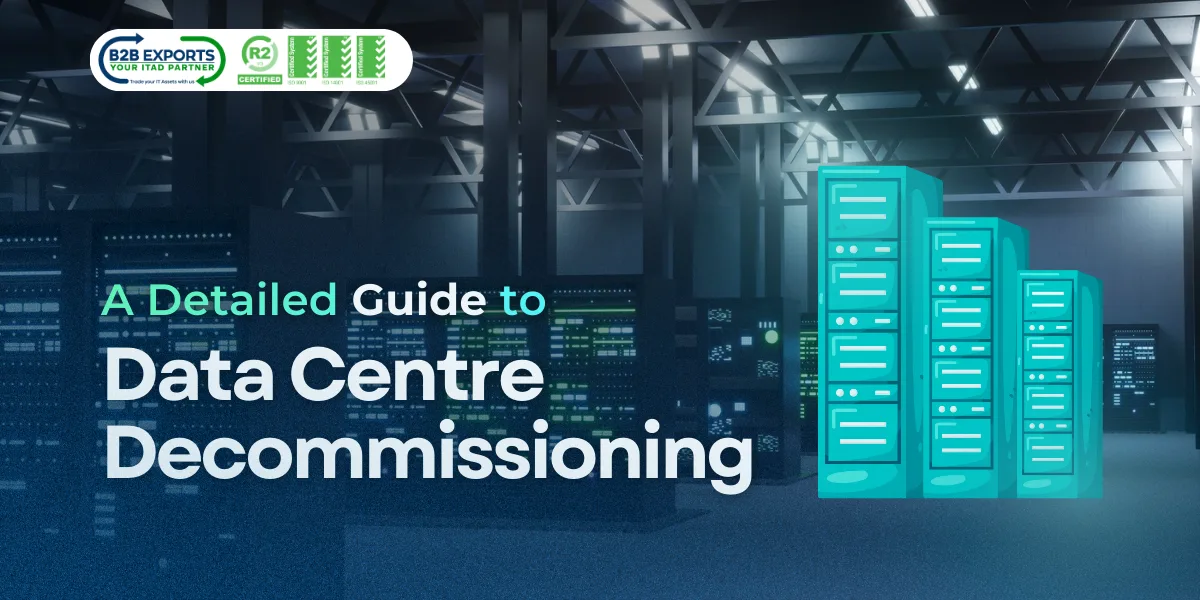Complete Guide for IT Asset Disposition

Today, IT asset disposition has become a fundamental need for every organization serving different communities. It helps the organizations to properly dispose of their retired IT assets. All the organizations that aim to serve responsibly should partner with a trusted ITAD partner to properly handle the end of life of the assets. Improper disposal of these assets isn’t just harmful to organizations but to the environment as well. Many IT assets still contain company’s confidential information, so it is important to dispose them properly to maintain confidentiality and environmental sustainability. This is where IT asset disposition, commonly known as ITAD, comes into existence.
It helps in safely wiping out data with a priority to data security and environmental sustainability. It uses data wiping methods like Cryptographic erasure and physical destruction. It helps in minimizing waste and maximizing asset utilization.
In this guide, you will get to know everything about IT asset disposition. Let's begin:
What is IT Asset Disposition?
ITAD is a process of safely disposing of retired or unused IT assets. Organizations often find this challenging, but with the right ITAD strategies, they can easily dispose of their obsolete IT assets. IT assets include laptops, desktops, servers and other important IT assets. There are different ways to dispose of these assets like recycling, IT Asset Remarketing and destroying. These IT asset disposition strategies ensure proper disposal of assets avoiding waste and protecting data security.
IT asset disposition helps organizations gain value from their outdated IT assets. It finds out whether the retired assets can be resold or donated. If not, then the data inside the device is wiped off with a physical destruction method. Without proper disposal, these assets can harm the environment and further increase the risk of data breaches and legal penalties. So, it's better to dispose of them with appropriate methods.
Whether you are an early-stage startup or a large corporation, a strong IT asset disposition strategy helps maintain confidentiality, reduce cost and contribute to the sustainable environment.
Why is IT Asset Disposition Important?
As organizations grow their business, they need more IT assets for better functioning. They invest in assets from desktops to servers and networking hardware. And it is equally important to handle the end-of-life of these assets. With the right IT asset disposition services, organizations can easily dispose of their obsolete assets and secure their data with a valuable contribution to the environment.
Key importance of ITAD:
1. Data Security:
The primary advantage of using ITAD services is data security. When IT assets are at the end of their life, they need to be securely disposed of with a promise of maintaining confidentiality. Because these assets might contain an organization’s sensitive data, which cannot be left unprotected as it increases the risk of data leaks that might expose an organization’s important information which can be misused. Thus, here ITAD helps to wipe the sensitive data from unused IT equipments securely. Robust IT asset disposition processes like data wiping, degaussing and IT destruction are used to erase the data safely. It helps organizations stay safe, secure and avoid any cyberthreats.
2. Maintain legal compliance:
Many organizations face heavy fines and other legal consequences due to lack of maintaining compliance with industry standards like GDPR and HIPAA. These regulations are necessary for proper asset disposal and waste handling. A certified disposition method always follows proper rules and regulations to ensure that organizations stay responsible for maintaining data security and environmental sustainability. It helps the organizations stay safe from heavy fines and legal penalties, reducing costs and ensuring that everything is done legally.
3.Recovering value from outdated IT assets:
Many organizations believe that unused IT equipments are a waste, but an IT asset disposition strategy helps in finding out whether these assets can be repaired or refurbished. It helps organizations find underused IT assets, refurbish them and allows them to recover some value from the initial investments they made in the assets. ITAD helps check the condition of every asset, its resale value and allows organizations to generate some revenue. This cost recovery feature makes ITAD a smart financial decision.
4. Reducing E-waste:
ITAD helps in reducing waste and allows your organization to contribute to the environment. IT equipments contain some parts like batteries and hard drives, which further contain hazardous substances like lead, mercury and cadmium that can harm the environment if not handled properly during disposal. ITAD ensures that every part of the assets is disposed of correctly with utmost priority to environmental sustainability. By partnering with a leading IT asset management company, organizations can manage the secure disposal of their assets with an alignment with the environment.
IT Asset Disposition Best Practices:
Here are some best ITAD practices that must be followed to get started:
1. Regular Asset Inventory:
Before starting with disposition, organizations should maintain a regular asset inventory. IT inventory tracking provides all the information about the assets such as asset serial number, asset type (software, hardware or cloud asset), assigned departments, purchase and retirement dates. A detailed asset inventory helps in tracking these assets, their usage and their end of life. It also benefits organizations in increasing asset utilization, ensuring no assets are lost and are properly disposed of in time.
2. Create a structured ITAD strategy:
A structured IT asset disposition strategy is the fundamental requirement because, without any strategy it is very difficult to manage the IT assets especially at the end of their life. Having a good ITAM strategy that aligns with your business goals and industry compliance standards, organizations can easily operate efficiently and reduce risk. Moreover, the strategy should manage assets throughout the IT asset lifecycle, reduce data breaching risk, follow industry regulations (GDPR, HIPAA, etc.) and decide how the assets must be disposed correctly. A definitive ITAD strategy will avoid confusion and help organizations follow trustable and legally compliant asset disposition.
3. Implement secure data destruction methods:
All the practices that are being followed are primarily for security purposes and if that objective isn’t achieved, then ITAD loses its significance. All the data must be wiped off securely in accordance with industry-recognized standards like NIST 800-88 and DoD 5220.22-M.
There are different types of IT asset disposition methods depending on the condition of the asset:
Data wiping: It is used when the assets are still usable, data inside them is securely wiped off so that the assets can be reused.
Degaussing: It is used when data erasing is more important than reuse. A strong magnetic field is used to erase the data from magnetic storage devices like hard drives and tapes. Data becomes irrecoverable after performing degaussing and assets cannot be reused after this.
Physical destruction: In this method, hardware shredding is used for the physical destruction of the assets ensuring maximum data protection.
4. Choose a certified ITAD partner:
Choosing the right IT asset disposition company is an essential step in executing ITAD. Not every company follows industry standards, so it is very important to always partner with a trusted company that follows industry standards for data security, environmental sustainability and legal compliance with important certifications like R2V3 (Responsible Recycling) and e-Stewards. A trusted ITAD company always follows a correct IT asset disposition system and provides complete documentation for verification which minimizes legal and functional risk.
5. Stay up to date with industry regulations and standards:
A certified IT asset disposition company always keeps itself updated with the present industry regulations for data security and responsible electronic waste handling. Some industry recognized laws are GDPR, HIPAA and NIST 800-80. It is not necessary that these laws are static, they are regularly updated. Thus, it is important to regularly check on these updates. Partnering with a versatile ITAD provider helps organizations stay updated with ongoing industry regulations and avoid failure in meeting compliance.
Types of IT Asset Disposition:

ITAD provides different types of methods according to the condition of the IT assets. It helps in performing suitable disposition methods that align with the current condition of the assets. Choosing a correct method depends on other factors too such as data sensitivity and organizational goals.
Let's understand all the major IT asset disposition methods:
1. Remarketing and Resale:
This method is brought into action when the assets have become aged but are still in working condition. The assets are then refurbished and are sold in the markets. It helps organizations generate some revenue while extending the assets’ life and preventing e-waste. An effective IT asset disposition strategy involves IT Asset Remarketing as a key method to increase asset utilization and help people afford IT equipments in a low budget.
2. Recycling:
When assets reach the end of their lives and are no longer needed, recycling is the best way to get rid of the assets. An experienced IT asset disposition company ensures that materials like metals, plastic and glass are recycled. It helps organizations stay compliant with environmental regulations and handle the waste properly.
3. Donations:
The assets that are no longer needed for internal operations but are useful can be donated to schools, hospitals and non-profit organizations. As a part of IT asset disposition process, proper sanitization of the assets is necessary to ensure proper data removal, avoiding any data breaches.
4. Data destruction:
Data destruction is the best possible method to deal with the assets that contain extremely important data. Reselling it may lead to a risk of data recovery and its misuse. It is important to permanently destroy the data to avoid any data leaks. Data destruction can be performed using shredding, degaussing and data wiping methods. A good IT asset strategy involves secure data destruction to help organizations meet compliance requirements like GDPR and HIPAA.
5. Parts Harvesting:
A smart IT asset disposition service involves internal parts harvesting. If a complete asset cannot be resold or reused, its essential parts like RAM, hard drives and CPUs are recovered for reuse and resale. This approach promotes reusing and utilizing not just an entire asset but the important parts of it. Additionally, it helps in contributing to the overall economy in the IT ecosystem.
Difference between IT Asset Disposition and Destruction

Disposition:
Disposition is a process of handling retired IT assets that have become obsolete. This is a broad process that involves several methods used for asset disposal. Common disposition methods are IT asset remarketing, recycling, donating or destroying. So, destruction is one possible method in disposition.
The core objective of disposition is to extract some value from the retired assets and reduce electronic waste by reselling, recycling and donating.
Destruction (IT Data Destruction):
Destruction is a specific process which comes under disposition. It is used to physically break the assets so that they can’t be reused. It is performed to protect sensitive business information. It uses methods like shredding, degaussing and data wiping. It erases data in a way that it cannot be recovered.
The key objective of destruction is to protect data, ensure compliance and safely dispose of hazardous materials.
IT Asset Disposition Process:

IT asset disposition is a process of getting rid of the unused IT assets responsibly and securely. The ITAD process must be followed in a structured manner to achieve strategic objectives. Let us walk through the complete ITAD process:
1. Asset inventory and tagging:
The first step in the process is to identify and record all the retired IT assets with a strong IT inventory tracking system. During significant operations like Data Center Decommissioning, it becomes even more crucial to maintain IT inventory. All the IT assets like laptops, desktops, servers and networking devices must be mentioned in it. Asset tagging is important to keep track of asset usage and decide the disposal accordingly.
2. Data security and certified destruction:
A certified data destruction service provider ensures that all the assets experience secure data destruction while remaining in compliance with international standard regulations like NIAT 800-88 and avoid the risk of data breach. Proper hard drive disposal involves certified data wiping or physical destruction like shredding. A good IT asset disposition company always provides a certificate of destruction to satisfy compliance requirements and smooth auditing.
3. Evaluation and value recovery:
Many assets become useless for organizations even after being in a working condition. These assets are refurbished and resold. This approach helps organizations recover some value while reducing electronic waste. In some cases, these assets are often donated to NGOs which makes a valuable contribution to social welfare.
4. Environmentally responsible recycling:
ITAD performs responsible recycling of the assets and their parts that might harm the environment. A reliable IT asset disposition system assures proper recycling of materials like plastic, metal and glass according to environmental regulations. The primary objective is to prevent the release of hazardous materials into landfills.
5. Documentation and reporting:
The final step in the process involves documentation and reposting of every asset processed. Proper documenting and reporting provide a detailed record of every asset. This includes audit logs, serial numbers, data destruction records and recycling documentation. This documentation supports organizations in meeting regulatory requirements and complies with standards like ISO 14001 and R2. It enables a clear and auditable IT asset disposition service.




